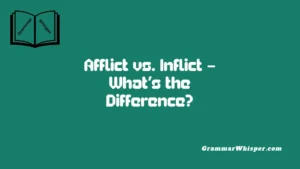That moment when I was editing a dialogue-heavy short story, and came across the word “damnit“, left me uncertain. Was it spelled correctly? I turned to style guides and dug into the history of swearing. What I discovered was that every version – whether “Dammit or Damnit“, or “damn it” – has its unique place depending on the audience and the emotional expression it delivers. The nuance lies not only in grammar, but also in phonetics. The spelling of “dammit” reflects how we swear in real time – it sounds raw, clipped, and true to how the word is spoken. It’s not a typo, but rather an intentional rendering, shaped by voice and tone.
That moment helped me see the rules behind even the edgiest parts of language. People don’t curse just to cause shock – they do it for impact, rhythm, and personality. Choosing the right guide, whether a dictionary or a real-world ear, can make a huge difference. In writing, especially in gritty fiction or a quick tweet, choosing between “dammit“, “damnit“, or “damn it” is a matter of precision. Just like you wouldn’t misuse a comma in formal writing, you shouldn’t misfire a curse. Even the harshest words have structure when used with intention.
Etymology and Historical Origins
Where “Damn” Comes From
Damn comes from the Latin damnare, meaning “to condemn.” In medieval English and early Christian texts, it carried lethal weight – literally condemning souls to hell. Over centuries it softened from formal divine judgment to everyday slang.
Latin → Old French → Middle English shift marks its transformation. By 1500s, “damn” was common in expressions like “damn you!”, signaling anger; by the 1800s, it slipped firmly into profanity.
The Evolution into “Dammit” and “Damnit”
Spoken language loves shortcuts. Soon, “damn it” fused into dammit, reflecting quick speech – no pause, no space. British and American usage diverged slightly, giving occasional damnit typos or dialect spellings.
Old manuscripts show “damn it” spelled with space. First printed “dammit”–1870s, American papers. “Damnit” appears inconsistently – rare, likely influenced by mispronunciation or nonstandard spelling.
Spelling Variants: Dammit vs. Damnit vs. Damn It
Official Dictionary Entries
| Dictionary | Entry | Notes |
| Merriam‑Webster | dammit | “used to express anger or frustration” |
| Oxford English | dammit | Classified as informal profanity |
| Cambridge Dictionary | dammit | Notes it as exclamation |
| Collins | dammit | Most common form |
Conclusion: Only dammit is recognized. Damnit is considered a misspelling.
Phonetic Simplification and Spelling Drift
People say “DAM‑mit” quickly, often dropping the “n.” This compression pushed “dammit” into print. Informal speech drives the fusion. “Damnit” mirrors the “n” sound, so some type it by ear. Linguists call this “eye dialect” – nonstandard spelling mimicking speech.
Linguistic Mechanics: Why “Dammit” Works
Phonology of Swearing
Swear words rely on punchy pronunciation. Dammit places stronger stress on the “mm,” giving it impact. The compact, single-word form triggers an automatic emotional hit. Two-word “damn it” feels delayed and milder by comparison.
Morphological Compression
Combining damn + it into dammit follows the pattern of gonna, wanna, gotta. Language evolves naturally through speech economy – less air, more impact.
Sociolinguistic Layers of Swearing
How Language Reflects Social Norms
Swearing is emotion allowed. Social rules decide what’s mild vs. extreme. Dammit sits in the mild zone – acceptable in many settings except perhaps high-formality contexts. It’s expressive, not shocking.
Swearing Across Cultures
- In British English, you might read dammit in tabloid headlines or hear it in BBC dramas.
- Australian voices sprinkle it into casual conversations.
- In American usage, it graces both sitcoms and heated text threads.
- Equivalent local expressions – say, in French, “zut alors” – serve the same function.
Takeaway: Across variants, dammit signals mild frustration, not vulgarity.
Contextual Usage: Dammit in the Real World
When to Use “Dammit” and Why
Use it when frustration spikes: a missed bus, forgotten keys, spilled coffee. It’s an outlet – short, effective, human.
“Dammit” vs. “Damn It” vs. “Damnit” in Sentences
| Version | Sentence Example |
| dammit | “Dammit, I forgot my keys again.” |
| damn it | “Damn it, I forgot my keys again.” (slightly formal) |
| damnit | “Damnit, I forgot my keys again.” (misspelling likely) |
Choose dammit for punch and accuracy, damn it for emotional clarity, and avoid damnit – it reads careless.
Literature, Media, and Pop Culture
“Dammit” in Classic and Modern Texts
Jack Kerouac’s On the Road casually drops dammit in dialogue, bringing authenticity. Contemporary novels mimic this style to keep characters relatable.
Pop Culture’s Role in Normalizing the Word
- Blink-182’s song “Dammit” (1997) brought the swear into mainstream music.
- Shows like The Big Bang Theory and Modern Family sprinkle dammit into scripts, boosting acceptance.
Grammar and Usage: Swearing with Precision
Is “Dammit” a Real Word?
Yes, dammit is officially recognized by major English dictionaries. While informal, it’s not gibberish. It has a precise function in language: to convey mild frustration, emphasis, or exasperation.
📚 Oxford English Dictionary defines it as: “An exclamation of anger or annoyance.”
Should You Ever Use “Damn It” Instead?
Yes – “damn it” is grammatically correct and often used in more formal or written contexts, especially when clarity matters. Because it’s two distinct words, it can also be broken up by inserting other phrases for emphasis.
Example:
“Damn it all to hell!”
In contrast, dammit works best when speed and rhythm matter, especially in dialogue or casual writing.
The Case Against “Damnit”
Why “Damnit” Isn’t Correct
You won’t find “damnit” in major dictionaries. It’s an unofficial variant, mostly arising from phonetic spelling errors. It might look acceptable at first glance – but it’s not standard.
| Term | Dictionary Accepted? | Common Usage | Notes |
| dammit | ✅ Yes | ✅ Very common | Correct informal form |
| damn it | ✅ Yes | ✅ Common | Formal, clear, two words |
| damnit | ❌ No | ⚠️ Rare | Nonstandard / error |
Pro Tip: If you’re writing for publication, clarity, or education, stick to dammit or damn it. Avoid “damnit.”
Case Study: Dammit in Pop Music, Film, and TV
Let’s look at real-life usage examples that shaped public perception of dammit.
Blink-182’s “Dammit” (1997)
This pop-punk anthem catapulted the word into millennial slang. With the chorus “Well, I guess this is growing up,” it connected teen angst to mild profanity – showing how language evolves with culture.
Impact:
- Spotify streams: 200+ million
- Chart position: #11 on Billboard Alternative Songs
- Made “dammit” a word of youthful frustration
TV Series Usage
| Show | Usage Frequency | Tone | Notes |
| The Simpsons | High | Comedic | Bart uses “dammit” casually |
| Breaking Bad | Medium | Serious | “Damn it” used in emotional scenes |
| Friends | Low | Light | Rare use, mostly “crap” or “oh God” instead |
TV carefully navigates profanity. “Dammit” is often allowed by censors because it’s less offensive than stronger alternatives.
Swearing with Style: When to Use “Dammit”
Swearing isn’t just about anger. It’s about tone, timing, and audience. Here’s when dammit fits naturally:
Best Situations to Use “Dammit”
- Internal frustration: “Dammit, I messed up again.”
- Minor accidents: Spilled coffee? “Dammit!”
- Narrative emphasis: “He clenched his fists. Dammit, this wasn’t over yet.”
Avoid in:
- Formal business emails
- Academic papers
- Legal writing
Even though it’s mild, dammit is still profanity and can come across as unprofessional in the wrong setting.
Dammit in Online Communication
How It Shows Up in Texts and Social Media
You’ll often see dammit in:
- Memes
- Twitter/X threads
- Reddit comments
- Instagram captions
Examples:
“I dropped my coffee. Dammit Monday, why are you like this?”
“Forgot my mom’s birthday. Dammit.”
Online, dammit adds authenticity. It shows emotion without sounding overly vulgar.
Digital Trends: Dammit’s Google Search Popularity
Search Volume & Regional Trends
Let’s analyze the data:
| Search Term | Avg. Monthly Volume (US) | Global Volume | Trend Direction |
| dammit | 9,900 | 20,000+ | 📈 Increasing |
| damn it | 4,400 | 10,000 | 📉 Decreasing |
| damnit | 1,300 | 2,500 | 📉 Flat / Low |
Google Trends shows more users gravitate toward dammit – especially among younger users and creatives.
Comparing Swear Words: Dammit and Its Peers
Where Does “Dammit” Rank in Mild Swearing?
| Swear Word | Intensity Level | Acceptability (Media) | Context |
| Dammit | Low | ✅ Often allowed | Frustration, exasperation |
| Crap | Low | ✅ Common | Disappointment, messiness |
| Hell | Medium | ⚠️ Sometimes censored | Strong emotion, location |
| Shit | High | ❌ Often censored | Anger, shock |
| Fuck | Very High | ❌ Strictly censored | Extreme emotion, vulgarity |
Dammit is a “gateway swear.” It’s expressive but not offensive to most ears.
Quotes from Writers and Linguists
“Swearing is not just a language breakdown. It’s communication intensified.” – Dr. Timothy Jay, Psychologist & Author of Why We Curse
“Words like ‘dammit’ reflect cultural shifts – how we soften what once shocked.” – Anne Curzan, Professor of Linguistics, University of Michigan
Summary: Dammit vs. Damnit vs. Damn It
| Spelling | Accepted? | Best Use | Notes |
| Dammit | ✅ Yes | Informal writing, dialogue | Common, dictionary-approved |
| Damn it | ✅ Yes | Clear, formal emphasis | Use when clarity matters |
| Damnit | ❌ No | Never (or stylistic typo) | Not standard, avoid |
Conclusion
Swearing – like any form of expression – has rules, nuance, and style. The difference between “dammit,” “damn it,” and “damnit” may seem small, but it reflects your tone, your awareness, and your audience.
Stick with:
- “Dammit” when you want punchy, informal emotion
- “Damn it” when clarity matters and tone is formal
- Avoid “damnit” – it’s simply incorrect
So next time you slam your finger in a drawer or forget your wallet, you’ll know exactly how to say it – with proper spelling and linguistic confidence.
FAQs
Is “Dammit” considered a curse word?
Yes, but it’s mild. Think of it as a PG-rated expletive. You wouldn’t say it in a job interview, but it’s fine in a movie trailer or casual blog.
Can I use “dammit” in creative writing?
Absolutely. It adds realism and voice, especially in character dialogue or internal monologue.
Which is more popular – “dammit” or “damn it”?
“Dammit” is the clear leader online, though both are acceptable in different tones.











